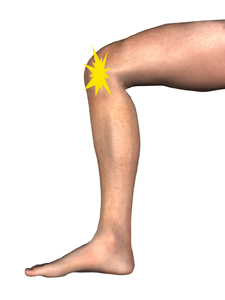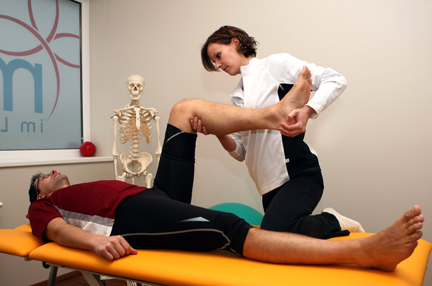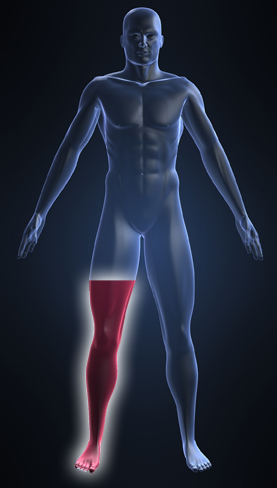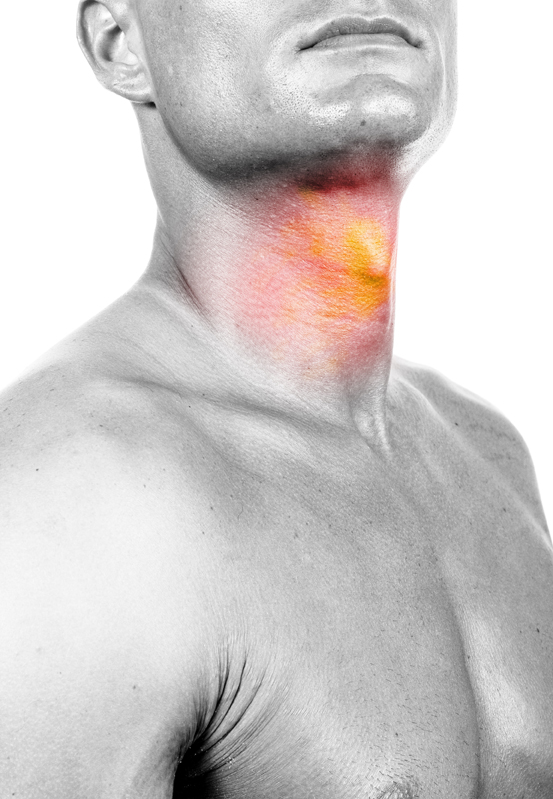Clinical Protocols
The following is a series of clinical protocols developed by major contributors in the field of biofeedback and physical therapy. We are proud to offer these protocols to the professional community through the world wide web in an effort to improve knowledge in the use of electromyography as an effective tool for physiotherapy.
Post Radical Prostatectomy Urinary Incontinence
Prostate cancer is one of the most prevalent cancers in western countries and is the third leading cause of death in men. Radical Prostatectomy (RP) is the gold-standard treat-ment for prostate cancer. One of the biggest concerns regarding RP is urinary incontinence (UI). Depending on the definition, UI occurs in 8% to 87% of patients who undergo RP.
Read more…
Patellofemoral pain is a common ailment affecting one in four of the general population(6). It is caused by a variety of factors including abnormal lower limb mechanics, Vastus Medialis Obliquus (VMO) insufficiency, tight lateral structures and tight anterior and posterior muscles. The condition often develops gradually and is characterized by a diffuse ache in the area of the anterior knee. Pain is a significant factor since it will inhibit muscular activity and alter lower limb function. Anterior knee pain is often diagnosed as chondromalacia patella(2). This diagnosis is only correct when a softened and fissured patellar under-surface is seen during diagnostic imaging or surgery(2). Often, no cartilaginous pathological findings are present in patients who otherwise complain of severe knee pain and functional disability, especially during prolonged sitting, stair climbing or sporting activities.
Anterior shoulder instability and impingement are common athletic complaints associated with overuse, joint laxity, post-traumatic dislocation and muscle imbalance. While traditionally treated as clinically discrete entities, it is now accepted that considerable overlap exists between functional instability and anterior impingement(1-3).Until recently, rehabilitation programs have emphasized subscapularis strengthening on the assumption that this muscle provided an anterior buttress, preventing anterior humeral head subluxation(4-6). Turkel (1981) has demonstrated inability of the subscapularis to cover the anterior humeral head in abduction and external rotation(7) and Garth reports that internal rotation forces actually contribute to anterior displacement(2). These findings provide an explanation for high failure rates of traditional rehabilitation programs(8-11).
Following an anterior cruciate ligament (ACL) reconstruction, immobilization and/or disuse of the operative limb can result in significant quadriceps femoris (QF) muscle atrophy and weakness, even within the first few days following surgery and certainly the first few weeks1. The focus of ACL rehabilitation programs is, therefore, the recovery QF muscle force and function (figure 1). Rehabilitative exercises during the early phases of treatment typically include QF muscle setting (QS) and straight leg raises (SLR). Often, these exercises are difficult to perform during the initial post operative weeks because of pain, edema, and possibly a disruption in normal joint receptor activity 2,3. If joint receptor feedback is distorted, the facilitory and inhibitory influences of this feedback on joint musculature are distorted and normal muscle contraction patterns become irregular and less effective. This may impede the performance of rehabilitative exersise and the recovery of muscle control and strength.
Urinary and Fecal Incontinence
Incontinence is a major healthcare problem costing a conservative estimate of $15 billion, annually, in the USA. This reality is mirrored in countries worldwide. Patients with this problem often lead lives of quiet desperation and social isolation.
Incontinence is among the leading causes of nursing home admission, with approximately 50% of all residents being incontinent. While it is estimated that the number of incontinent geriatric patients can be as high as 80%11, it is more difficult to estimate the incidence in younger populations, though studies by Nygaard show incontinence to be common in young nulliparous women, particularly during physical activities. One Danish study5, conducted with a group of 45-year-old women, found that 22% experienced stress incontinence. It was also noted that only three percent of these women sought medical attention for their problem.
Virtually everybody who has had an amputation reports feeling sensations which appear to emanate from the amputated portion of the limb. Most of the time, these “phantom” sensations are painless and of sufficiently low intensity to be no more than a mild distraction(9). The sensations are usually similar to those which would be felt in an intact limb, including warmth, itching, sense of position, and mild squeezing. Awareness of details of the limb’s shape and perceived ability to move it tend to fade with time. However, almost all amputees report continuing to feel at least some phantom sensations throughout the remainder of their lives. When phantom sensations become intense enough for the amputee to define them as painful, they are called “phantom pains”. The neural mechanisms which permit perception of phantom limbs are well recognized(3,4). Sensations reaching the brain are identified for location on the skin by the homunculus, in the sensory cortex, which contains a representation of the entire body surface. Thus, a pinch of the left index finger tip stimulates a location on the homunculus representing the left index finger tip.
Headache is the most common pain complaint(11) and the most frequent medical problem seen in medical clinics(7). Most experts(3) believe that the majority of headaches are muscle tension-type. Community-based epidemiological studies have found that 14% of men and 29% of women have had headaches either every few days or headaches which significantly bothered them(9).
Improper work habits, poor workstation ergonomics, and environment can lead to physiological dysregulation such as muscle soreness, fatigue, and injury (Grandjean, 1987). Some workers develop chronic neck and upper limb pain also known as repetitive strain injury. (RSI), cumulative trauma disorder (CTD) or overuse syndrome, from long hours of repetitive tasks at personal computer workstations. Workers with RSI suffer loss of productivity and income with increasing medical costs. RSI accounted for forty percent of workers compensation cases in 1990. Discomfort and injury can shape the way PC users feel about their job and computers.
Effortless Diaphragmatic Breathing
The underlying premise of this protocol is if the startle response or alarm reaction is embedded in the performance of an activity which adversely affects the respiratory patterns (e.g. gasping, thoracic breathing, breath holding), then changing the respiratory patterns with effortless diaphragmatic breathing may lead to an improvement in health and performance. This protocol includes an assessment of dysfunctional breathing and training strategies towards effortless breathing.
Respiration is under both voluntary and involuntary control, and often occurs without awareness unless symptoms such as breathlessness are present. Yet even without awareness or symptoms, breathing can be highly dysfunctional. Respiration is customarily described in terms of rate, volume, gas exchange (02 and CO2), airway reactivity, and mast cell activity (Fried, 1993; Wientjes, 1993); however, a major omission is the breath pattern.
Vulvodynia is a descriptive, not a diagnostic, term covering a wide range of disorders which have, as one component, pain in the vulvar area. Vulvar pain can arise from many sources. In no other area of biofeedback practice, is it more important to rule out all medical reasons for the symptoms prior to commencing treatment, and to treat patients only under prescription from a specialty physician, not on self-referral. While there are many acute problems that may initiate or prolong introital dyspareunia (pain on vaginal penetration) or vulvar burning sensations, you will probably be referred only the chronic cases. If there are still acute problems present, these must be remedied prior to further treatment. Gynecological sources of vulvovaginal discomfort include vaginal infections, fungal (a wide range of yeast overgrowth includes hundreds of identified species) or bacterial (Bacterial Vaginiosis). These infections cause changes in the vaginal ecosystem such that vaginal discharge is highly irritative to the vulvar tissue. Another major source of vulvar discomfort is hormone related and occurs perimenopausally and post menopausally. Estrogen deficiency frequently leads to a thinning of vulvar tissue with consequent irritation. Dermatological sources of vulvar discomfort include a variety of conditions involving vulvar tissue changes such as lichen simplex chronicus, lichen planus and lichen sclerosis.
Peak Performance Training with Electrodermal Biofeedback
Even though athletes report that during competition their mental attitudes account for 80% or more of their success, few training programs systematically train athletes to control their mental attitudes. This protocol reports on the use of electrodermal response (EDR) biofeedback strategies to enhance peak performance. The biofeedback strategies are derived from our two year Mental Peak Performance Research and Training Program with United States Rhythmic Gymnastics Team (USRGT). These strategies, however, can be applied to any performer such as a figure skater, gymnast, sharp shooter, dancer or musician.
In our multidisciplinary training program, we discovered that biofeedback was a powerful tool to enhance peak performance. Biofeedback uses instrumentation to monitor and feedback the physiological changes that continuously occur within an individual.
Towards an Integrated Approach of sEMG Utilization: Quantative Protocols of Assessment and Biofeedback
Surface electromyography is a computerized electrophysiological technology that can be utilized in an array of approaches. It is an objective tool for assessment and diagnosis of muscular electrical activity in health and disease. It is an objective electronic monitor during the course of physical and occupational therapy for most neuromuscular conditions.
sEMG is similar to a voltmeter device. It measures the summation of passage of multiple units of action potentials (m.u.a.p) between two points on a muscle belly from the vantage point of the skin surface. It can also measure the frequency of passage of the m.u.a.p.s. The summation of the action potential passage shows up as an amplitude form, i.e. the greater the number of passing action potentials, the higher the amplitude of the micro-voltage. The classic distance between the two surface electrodes is two centimeters. If the electrodes are placed at a larger distance, the number of action potentials coursing between the two points will be larger and thus the amplitude will be higher.
Protocol for use of EMG and Tactile Biofeedback in Treatment of Temporomandibular Disorders and Myofacial Pain
Temporomandibular disorders (TMDs) are a group of problems characterized by a dull, deep orofacial pain typically in front of the ear, the muscles of mastication, the masseter in particular, or the temporomandibular joint (TMJ). People with a TMD might also complain of other facial pain, tension-type headaches, neck, shoulder, or back pain1-7. The pain associated with TMDs can result in decreased function. TMD patients might also present with a variety of jaw problems, such as difficulty in maximally opening the jaw, locking in the open or closed position, clicking, popping or grating noises, due to abnormal position of articular disc. Degenerative disorders that lead to erosion and flattening of the condoyle, as well as bone spurs or other undesirable growths on the condoyle adversely affect the TMJ. The symptoms presented by TMD patients can mimic a variety of disorders, and patients may seek care from several different healthcare providers. Forty percent of TMD patients who were referred to a tertiary dental care center had previously consulted a physician for the problem. The varied symptomatology of TMD patients, resulting in consultations with several health care providers may account in part for the significantly greater 2-year cost of treating TMD patients compared to patients without TMDs.
The research literature reports a few case series studies in which swallowing therapy utilizing surface EMG biofeedback has led to positive treatment outcomes for patients with chronic (treatment refractory) swallowing difficulties post stroke. Additionally, the literature reports that surface EMG biofeedback is useful for teaching the correct performance of two specific swallowing therapy maneuvers: the Effortful Swallow (indicated when food or liquid is only partially cleared from the throat after a single swallowing attempt) and the Mendelsohn Maneuver (indicated when the upper esophageal sphincter does not open fully during a swallow attempt, resulting in incomplete clearance of food or liquid from the throat to the esophagus).









